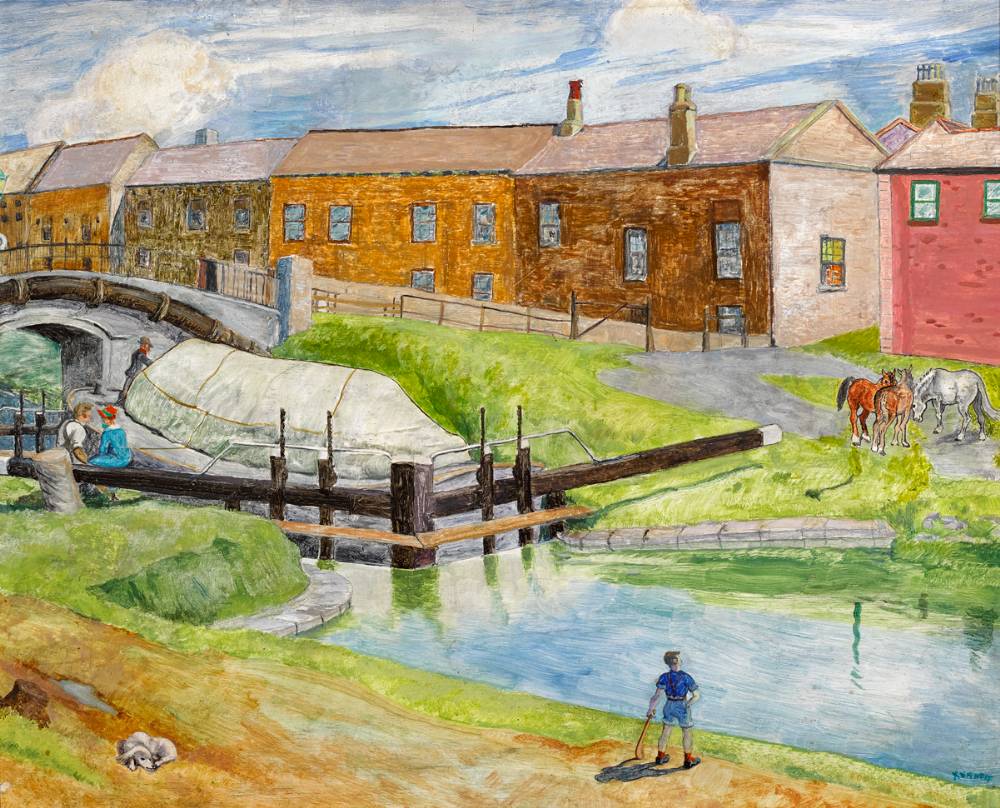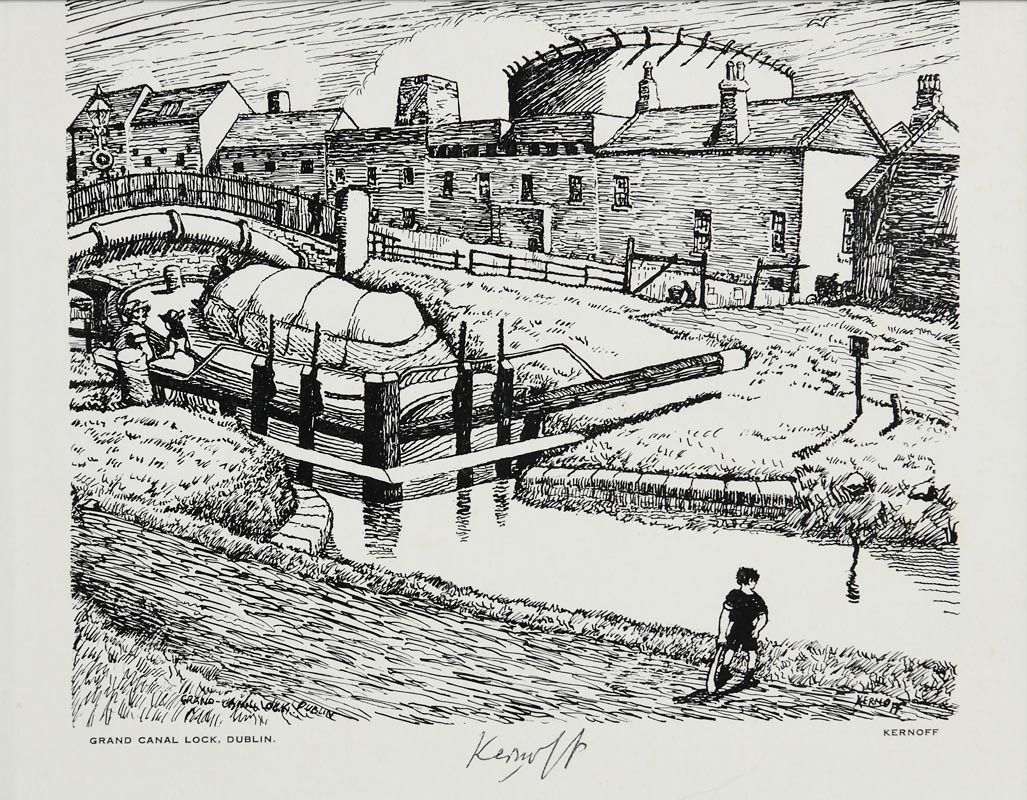Harry Kernoff, RHA (1900 - 1974) Canal, Wilton Place, Dublin 1940 Oil on board, 54 x 77cm (21 x 30.5'') Signed An evening summer's sun, beginning to set to the West casts the long blue shadows, which so many painters loved to render ''en plein-air''. Using the notion that as shadows represent a coloured area in nature temporarily deprived of a light source they possess the qualities of the colour but in shadow relying on the laws of complementary colour to give a red hue or a cold tone to the colour thus cast. Kernoff has the capacity to distil a moment of tranquility and with the oddity of perspective which he liked so much, an elongated form of perspective giving an air of otherworldliness to his Urban scapes, its always a sunny day in these Dublin works by Kernoff, a moment of stillness, and the figure sitting reading on the bench where Patrick Kavanagh sat and thought and recorded so often and today honoured in the Kavanagh Seat, it is of a lost Dublin. Lost if not quite in the mists of time then certainly has the apperance of a hidden quiet Dublin. The buildings on the left hand side of the painting have been in so many cases replaced by modernism, but there is sufficient left of that part of the city for the visitor to visit and think on, watching the reflecting of the passing traffic in the still waters of the canal or the swans sweeping majestically up and down the canal claiming it as their own. Kernoff has the capacity to represent the banal and the ordinary in a visual language which makes it memorable. Patrick Kavanagh (1904-1967) the poet from Inniskeen, Co. Monaghan had that same capacity believing that the ploughing of one field was sufficient for any man. Thus it is that the poet who was first published by George Russell (AE) in The Irish Statesman (1928) decided to meet his hero and walked to Dublin in 1931 from Monaghan. His autobiography The Green Fool was withdrawn in 1938 after Oliver St.John Gogarty threatened libel action. Moving to Dublin in 1939 Kavanagh was ignored by Gogarty and Douglas Wylie and their set but made his way with other outsiders like Kernoff around Dublin's literary haunts, Davy Byrnes and in McDaids he met with Tom Nisbet RHA who ran the original Grafton Gallery and a literateur of some power and ability himself, along with the poet and Abbey director Fred Higgins, Maurice MacGonigal Mervyn Wall, Tim Mulhall and Martin O'Direan. But like Kernoff he remained outside the powerful Anglo literary set in Dublin and his 1940s poem The Great Hunger depicting loneliness and sexual frustration was considered for prosecution by the authorities. Published by Frank O'Connor and W.B. Yeats wido George in 1942 under the Cuala Imprint it was finally publicly staged in in 1983 by Tom McIntyre, previewing in the Tyrone Guthrie Centre, Newbliss, Co. Monaghan and those of us who were present at that night despite the appalling freezing night were stunned by the vivid images thus conjured up by the writer and actors alike, it then opened to great acclaim in the Abbey Theatre. So here we have the image of a man, considered by some to be Kavanagh himself, reading alone by the side of the canal, and where now sits his life-sized bronze figure on a bench finally and forever considering his beloved canal and looking towards not just the city which he admired so much but the bookshop where the Miss Parsons' ran an important literary centre by way of the famous Parsons Bookstore. Ciaran MacGonigal March 2005 Harry Kernoff, RHA (1900 - 1974) Canal, Wilton Place, Dublin 1940 Oil on board, 54 x 77cm (21 x 30.5'') Signed An evening summer's sun, beginning to set to the West casts the long blue shadows, which so many painters loved to render ''en plein-air''. Using the notion that as shadows represent a coloured area in nature temporarily deprived of a light source they possess the qualities of the colour but in shadow relying on the laws of complementary colour to give a red hue or a cold tone to the colour thu
Harry Kernoff, RHA (1900 - 1974) Canal, Wilton Place, Dublin 1940 Oil on board, 54 x 77cm (21 x 30.5'') Signed An evening summer's sun, beginning to set to the West casts the long blue shadows, which so many painters loved to render ''en plein-air''. Using the notion that as shadows represent a coloured area in nature temporarily deprived of a light source they possess the qualities of the colour but in shadow relying on the laws of complementary colour to give a red hue or a cold tone to the colour thus cast. Kernoff has the capacity to distil a moment of tranquility and with the oddity of perspective which he liked so much, an elongated form of perspective giving an air of otherworldliness to his Urban scapes, its always a sunny day in these Dublin works by Kernoff, a moment of stillness, and the figure sitting reading on the bench where Patrick Kavanagh sat and thought and recorded so often and today honoured in the Kavanagh Seat, it is of a lost Dublin. Lost if not quite in the mists of time then certainly has the apperance of a hidden quiet Dublin. The buildings on the left hand side of the painting have been in so many cases replaced by modernism, but there is sufficient left of that part of the city for the visitor to visit and think on, watching the reflecting of the passing traffic in the still waters of the canal or the swans sweeping majestically up and down the canal claiming it as their own. Kernoff has the capacity to represent the banal and the ordinary in a visual language which makes it memorable. Patrick Kavanagh (1904-1967) the poet from Inniskeen, Co. Monaghan had that same capacity believing that the ploughing of one field was sufficient for any man. Thus it is that the poet who was first published by George Russell (AE) in The Irish Statesman (1928) decided to meet his hero and walked to Dublin in 1931 from Monaghan. His autobiography The Green Fool was withdrawn in 1938 after Oliver St.John Gogarty threatened libel action. Moving to Dublin in 1939 Kavanagh was ignored by Gogarty and Douglas Wylie and their set but made his way with other outsiders like Kernoff around Dublin's literary haunts, Davy Byrnes and in McDaids he met with Tom Nisbet RHA who ran the original Grafton Gallery and a literateur of some power and ability himself, along with the poet and Abbey director Fred Higgins, Maurice MacGonigal Mervyn Wall, Tim Mulhall and Martin O'Direan. But like Kernoff he remained outside the powerful Anglo literary set in Dublin and his 1940s poem The Great Hunger depicting loneliness and sexual frustration was considered for prosecution by the authorities. Published by Frank O'Connor and W.B. Yeats wido George in 1942 under the Cuala Imprint it was finally publicly staged in in 1983 by Tom McIntyre, previewing in the Tyrone Guthrie Centre, Newbliss, Co. Monaghan and those of us who were present at that night despite the appalling freezing night were stunned by the vivid images thus conjured up by the writer and actors alike, it then opened to great acclaim in the Abbey Theatre. So here we have the image of a man, considered by some to be Kavanagh himself, reading alone by the side of the canal, and where now sits his life-sized bronze figure on a bench finally and forever considering his beloved canal and looking towards not just the city which he admired so much but the bookshop where the Miss Parsons' ran an important literary centre by way of the famous Parsons Bookstore. Ciaran MacGonigal March 2005 Harry Kernoff, RHA (1900 - 1974) Canal, Wilton Place, Dublin 1940 Oil on board, 54 x 77cm (21 x 30.5'') Signed An evening summer's sun, beginning to set to the West casts the long blue shadows, which so many painters loved to render ''en plein-air''. Using the notion that as shadows represent a coloured area in nature temporarily deprived of a light source they possess the qualities of the colour but in shadow relying on the laws of complementary colour to give a red hue or a cold tone to the colour thu












Testen Sie LotSearch und seine Premium-Features 7 Tage - ohne Kosten!
Lassen Sie sich automatisch über neue Objekte in kommenden Auktionen benachrichtigen.
Suchauftrag anlegen